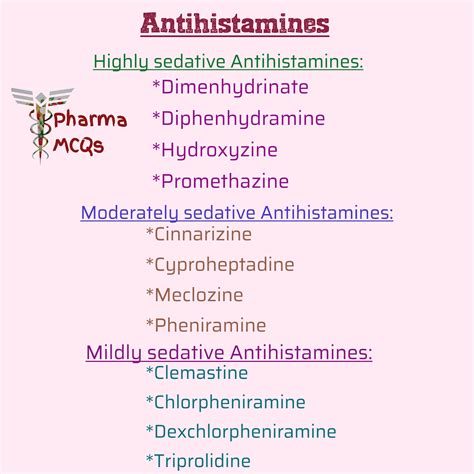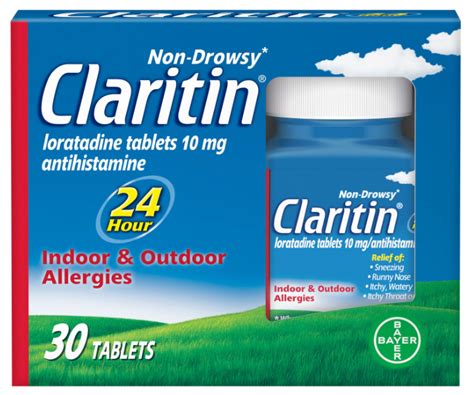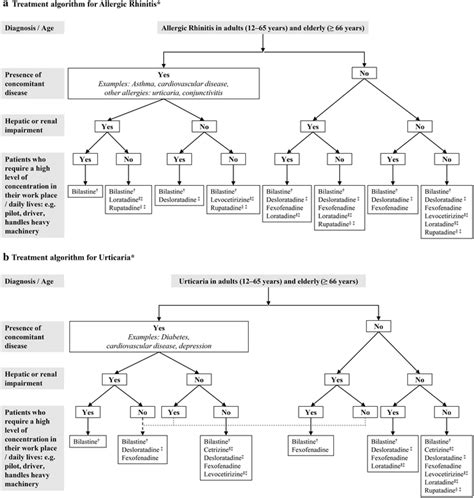Intro
Discover effective over-the-counter antihistamine options for relief from allergies, itching, and hives, including diphenhydramine, loratadine, and cetirizine, to soothe symptoms and reactions.
When it comes to relieving allergy symptoms, antihistamines are often the go-to solution. These medications work by blocking the action of histamine, a chemical released by the body's immune system during an allergic reaction. With so many over-the-counter (OTC) options available, it can be overwhelming to choose the right one. In this article, we will delve into the world of OTC antihistamines, exploring their benefits, working mechanisms, and steps to take when selecting the most suitable option for your needs.
Allergies can range from mild to severe, and their symptoms can significantly impact daily life. From itching and sneezing to congestion and hives, the discomfort caused by allergies can be unbearable at times. This is where antihistamines come into play, providing quick and effective relief from these symptoms. With the vast array of OTC antihistamines on the market, it's essential to understand how they work and which ones might be best suited for specific allergy types.
The importance of choosing the right antihistamine cannot be overstated. Different antihistamines have varying levels of effectiveness for different types of allergies, and some may have side effects that could be detrimental to certain individuals. For instance, first-generation antihistamines can cause drowsiness, which might be beneficial for nighttime use but could be a hindrance during the day. On the other hand, second-generation antihistamines are generally non-drowsy, making them more suitable for daytime use. Understanding these differences is crucial for managing allergies effectively and safely.
Understanding Antihistamines

Antihistamines are classified into two main generations: first-generation and second-generation. First-generation antihistamines, such as diphenhydramine, are known for their ability to cross the blood-brain barrier, which can lead to side effects like drowsiness, dry mouth, and blurred vision. They are effective but can significantly impact daily activities due to their sedative effects. Second-generation antihistamines, including loratadine and cetirizine, were developed to reduce these side effects. They are less likely to cross the blood-brain barrier, resulting in minimal drowsiness and other adverse effects, making them more suitable for individuals who need to stay alert during the day.
Benefits of Antihistamines
The benefits of antihistamines are numerous, particularly for those suffering from allergies. They provide quick relief from symptoms like itching, sneezing, and runny nose, improving the quality of life for individuals with allergies. Antihistamines can also be used to relieve itching and reduce the risk of allergic reactions in certain situations. Furthermore, their ability to induce sleep in some cases can be beneficial for individuals with nighttime allergies, helping them get a good night's sleep without interruptions from allergy symptoms.Types of Over-the-Counter Antihistamines

There are several types of OTC antihistamines available, each with its unique characteristics and uses. Diphenhydramine (Benadryl) is a first-generation antihistamine that is effective for relieving allergy symptoms but can cause drowsiness. Loratadine (Claritin) and cetirizine (Zyrtec) are second-generation antihistamines that provide 24-hour relief from allergy symptoms without the significant drowsiness associated with first-generation antihistamines. Fexofenadine (Allegra) is another second-generation antihistamine known for its non-drowsy formula and is often used for relieving symptoms of seasonal allergies.
Choosing the Right Antihistamine
Choosing the right antihistamine depends on several factors, including the type of allergy, the severity of symptoms, and the individual's lifestyle. For daytime use, non-drowsy antihistamines like loratadine or cetirizine might be preferred to avoid interference with daily activities. For nighttime use, a first-generation antihistamine like diphenhydramine could be beneficial due to its sedative effects. It's also important to consider any potential interactions with other medications and consult with a healthcare provider if necessary.Steps to Take When Selecting an Antihistamine

When selecting an antihistamine, there are several steps to take:
- Identify Your Allergy: Understanding the type of allergy you have is crucial. Different antihistamines are more effective for different types of allergies.
- Consider Your Lifestyle: If you need to stay alert during the day, a non-drowsy antihistamine might be the best choice.
- Read Labels Carefully: Look for the active ingredient and ensure it aligns with your needs.
- Consult a Healthcare Provider: Especially if you have other health conditions or are taking other medications, it's wise to consult with a healthcare provider to avoid any potential drug interactions.
Practical Examples and Statistical Data
Studies have shown that antihistamines are effective in relieving allergy symptoms in a significant percentage of the population. For example, a study on the efficacy of loratadine found that it provided relief from symptoms in over 80% of participants. Statistical data also indicate that the use of antihistamines has increased over the years, reflecting their importance in managing allergies.Side Effects and Precautions

While antihistamines are generally safe, they can have side effects, especially when not used as directed. Common side effects include drowsiness, dry mouth, and stomach upset. It's essential to follow the recommended dosage and consult with a healthcare provider if you experience any severe side effects. Precautions should also be taken when giving antihistamines to children or the elderly, as they may be more susceptible to side effects.
Interactions with Other Medications
Antihistamines can interact with other medications, which could lead to adverse effects. For instance, combining antihistamines with sedatives or tranquilizers can increase the risk of excessive drowsiness. It's crucial to inform your healthcare provider about all the medications you are currently taking before starting an antihistamine regimen.Conclusion and Future Directions

In conclusion, antihistamines are a vital component in the management of allergies, offering quick and effective relief from symptoms. With the variety of OTC options available, it's essential to understand the differences between them and choose the one that best suits your needs. As research continues, we can expect to see the development of even more effective and safer antihistamines. For now, by being informed and taking the right steps, individuals can better manage their allergies and improve their quality of life.
Final Thoughts
The world of antihistamines is vast and complex, but with the right information, navigating it becomes much simpler. Whether you're dealing with seasonal allergies or have a specific allergy that requires constant management, there's an antihistamine out there for you. Remember, always consult with a healthcare provider if you're unsure, and never hesitate to reach out for advice on managing your allergies effectively.What are the most common types of antihistamines?
+The most common types of antihistamines include first-generation antihistamines like diphenhydramine and second-generation antihistamines like loratadine and cetirizine.
How do I choose the right antihistamine for my allergy?
+Choosing the right antihistamine depends on the type of allergy, the severity of symptoms, and your lifestyle. Consider whether you need a non-drowsy option for daytime use or if a sedating antihistamine is preferable for nighttime use.
Can antihistamines interact with other medications?
+Yes, antihistamines can interact with other medications. It's essential to inform your healthcare provider about all the medications you are currently taking before starting an antihistamine regimen.
We hope this comprehensive guide to antihistamines has been helpful in understanding the world of allergy relief. Whether you're a seasoned user of antihistamines or just starting to explore your options, remember that managing allergies is a journey, and being informed is the first step towards a better quality of life. Feel free to share your experiences or ask questions in the comments below, and don't forget to share this article with anyone who might benefit from this information. Together, let's take control of our allergies and live life to the fullest.
